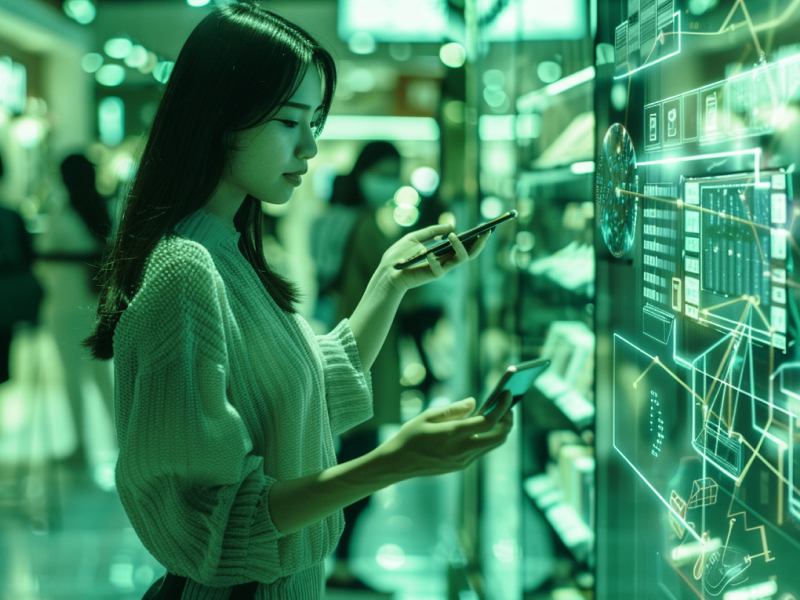Immersive customer experiences offer a unique opportunity to engage shoppers in ways that go beyond traditional methods. Leveraging advanced technologies, retailers can create environments that captivate and retain customers, ultimately driving loyalty and increasing sales.
What are immersive customer experiences?
Immersive customer experiences extend beyond simply replicating a physical store in a digital format though using advanced technologies like augmented reality (AR) and virtual reality (VR) to create memorable and engaging interactions.
Historically, technology has driven major changes in business processes. For instance, the transition from typewriters to word processors revolutionized office work by making document creation and distribution more efficient. Similarly, AR and VR are now transforming the retail sector by offering new ways to interact with products and services.
With physical retail locations facing challenges from the convenience of online shopping, immersive experiences provide a solution by offering unique, memorable interactions that can draw customers back into stores. These cater to customers’ desires for novelty and personalization, making shopping more engaging and enjoyable.
The future of retail and immersive customer experiences
Customers today are looking for more than products; they seek experiences that are fast, convenient, friendly, and unique.
According to a study by PwC, customers are willing to pay up to 16% more for products and services that come with good experiences. 32% of customers will abandon a brand after just one bad experience.
Speed, convenience, and user-friendliness are key factors in customer satisfaction. Immersive experiences can incorporate all these elements, creating an environment where customers feel valued and understood. Retailers can leverage these insights to design shopping experiences that meet and exceed customer expectations.
Discover what customers really want
Understanding customer preferences and behaviors is key for creating effective immersive experiences. Customers prioritize speed, convenience, friendliness, and uniqueness in their shopping experiences.
Retailers can use immersive technologies to address these preferences. For example, AR can provide instant information and visual enhancements, making shopping faster and more convenient. VR can create entirely new shopping environments that offer unique and engaging experiences.
Different types of immersion that captivate shoppers
Immersive experiences can engage multiple senses, creating a deeper connection between customers and products. The main types of immersion include tactical, sight, and narrative immersion:
- Tactical immersion: Engages the sense of touch by allowing customers to interact with products physically, which can include haptic feedback in VR environments, where customers can feel the texture and weight of virtual items.
- Sight immersion: Uses AR and VR to create visually engaging experiences. For example, VR can simulate a home environment with virtual furniture, allowing customers to see how products fit into their spaces. AR can overlay product information and visuals onto the real world, improving the shopping experience.
- Narrative immersion: Incorporates storytelling elements to create emotional connections with customers, such as lifelike sounds and creative visuals that draw customers into a brand’s story. For instance, a virtual tour of a vineyard can include ambient sounds and visual narratives about the wine-making process.
Retailers can integrate this deeper immersion to create comprehensive and engaging shopping experiences that resonate with customers and build up brand loyalty.
6 cutting-edge immersive solutions for retailers
Retailers today face the challenge of engaging a digital-savvy audience accustomed to the convenience and immediacy of online shopping. Adopting immersive technologies, they can offer customers unique and memorable shopping experiences that drive engagement and loyalty.
1. Revolutionize shopping with 3D visualizations
3D visualizations provide customers with an interactive way to explore products in detail. In an online store, these visualizations allow shoppers to view items from every angle, giving them a comprehensive understanding of the product.
Depth of detail is particularly beneficial for high-cost items, such as electronics or luxury goods, where customers want to be sure of their purchase before committing.
Research indicates that products with interactive 3D content can see up to a 30% increase in sales compared to static images.
For example, a consumer considering a new smartphone can rotate the device, zoom in on features, and see the product in various colors – reducing uncertainty, increasing customer confidence, and can boost conversion rates.
2. Fitting rooms with Augmented Reality mirrors
Augmented reality (AR) mirrors revolutionize the traditional fitting room experience by overlaying virtual items onto a customer’s reflection.
Shoppers can try on clothes, accessories, and even makeup without physically wearing them, streamlining the shopping process, and reducing the time and effort spent on trying multiple items. A shopper trying on a dress might see virtual jewelry, shoes, and handbags that complement the outfit, all suggested by the AR mirror, encouraging upselling and cross-selling.
Retailers report that customers using AR mirrors have a 20% higher purchase rate and a 15% increase in basket size compared to those who don’t.
3. Shopping with virtual assistants available 24/7
Virtual shopping assistants, often powered by AI chatbots, provide customers with personalized assistance at any time of the day.
Assistants can answer questions, offer product recommendations, and guide users through the shopping process, much like a human personal shopper. For instance, a customer browsing for a laptop might receive suggestions for accessories like a case or additional storage, tailored to their specific needs and preferences.
Virtual assistants improve customer satisfaction by providing instant support and personalized recommendations. Data shows that retailers using virtual assistants experience a 25% increase in customer engagement and a 35% boost in conversion rates.
4. Create engaging virtual environments for home shoppers
Virtual environments recreate the experience of shopping in a physical store, offering consumers the chance to explore products in a simulated setting from the comfort of their homes.
These can include virtual stores, showrooms, or even entire shopping malls, complete with interactive features.
Studies indicate that virtual environments can reduce return rates by 20%, as customers have a clearer understanding of the products they are buying.
A furniture retailer, for example, can use a virtual environment to showcase how different pieces look in a fully furnished room. Shoppers can walk through the space, interact with products, and even make purchases within the virtual setting. This saves time and travel costs for consumers while providing retailers with detailed insights into shopping behaviors.
5. Interactive livestream shopping
Livestream shopping combines the convenience of online shopping with the engagement of live demonstrations.
Retailers conduct live video sessions where they showcase products, answer questions in real-time, and interact with viewers. This format gained popularity during the pandemic and continues to be an effective way to reach customers.
During a livestream, a fashion retailer might showcase the latest collection, demonstrate how to style different pieces, and offer exclusive discounts to viewers.
Retailers leveraging livestream shopping have seen conversion rates up to 10 times higher than traditional e-commerce methods and a 30% increase in average order value.
6. Create buzz with pop-up stores and interactive classes
Pop-up stores and interactive classes offer retailers the chance to engage customers in a live, in-person setting. Temporary setups create a sense of urgency and exclusivity, driving both foot traffic and online buzz.
For example, a cosmetics brand might open a pop-up store in a busy city center, offering limited-time products and exclusive discounts. The brand can also host makeup classes where customers learn how to use the products, creating a hands-on, educational experience. Events generate excitement and social media activity, increasing brand visibility.
Pop-up stores can lead to a 20% increase in sales and a 40% boost in social media engagement during the event period.
Game-changing benefits of immersive shopping
Immersive customer experiences have the power to transform shopping from a transactional activity into a memorable and engaging journey. Advanced technologies are then leveraged to create interactions that resonate with customers, driving both satisfaction and loyalty.
Surprise customers with novelty and convenience
Customers today seek more than just products; they desire experiences that are novel, convenient, and personalized. Immersive technologies cater to these desires by providing unique ways to interact with products and brands.
- Novelty: Immersive experiences introduce customers to innovative ways of shopping. For instance, AR mirrors in fitting rooms allow customers to try on clothes virtually, adding a fun and engaging element to the shopping process. Novelty attracts customers looking for something beyond the mundane, making the shopping experience more enjoyable and memorable.
- Convenience: Technologies like virtual shopping assistants provide instant support and personalized recommendations, making the shopping process smoother and more efficient. Assistants can answer queries, suggest products based on customer preferences, and even guide them through the purchasing process.
Boost sales and brand loyalty
For retailers, immersive experiences translate into tangible business benefits. Through engaging customers in more meaningful ways, retailers can drive sales, increase loyalty, and build a stronger brand image.
- Higher conversion rates: Immersive technologies such as 3D visualizations and virtual environments give customers a detailed understanding of products, reducing uncertainty and increasing the likelihood of purchase. Studies show that products featuring interactive 3D content can see up to a 30% increase in sales compared to those with static images.
- Increased loyalty: Engaging customers with personalized and enjoyable experiences fosters loyalty. Customers who have positive interactions with a brand are more likely to return and make repeat purchases. According to PwC, customers are willing to pay up to 16% more for products and services that come with good experiences, highlighting the value of investing in immersive technologies.
- Reduced return rates: Providing detailed product information through immersive experiences helps customers make informed decisions, leading to fewer returns. Virtual environments that allow customers to visualize products in their own space or see them in action can reduce return rates by up to 20%.
The art of crafting immersive retail experiences
Creating a successful immersive experience goes further than blindly adopting new technologies. It requires a careful strategic approach that integrates these technologies into the core identity of the brand and addresses customer needs at the right time in the sales funnel.
Build immersive experiences rooted in your brand’s core identity
Immersive experiences should reflect the essence of your brand so that experiences are authentic and resonate with your target audience. Start with your brand’s mission and vision statements.
For instance, a women’s clothing store specializing in capsule wardrobes might focus on creating a seamless mix-and-match experience for customers. An in-store AR mirror could show how different pieces work together, while an online tool could use avatars to provide a similar experience.
Rooting these technologies in the brand’s core identity helps maintain consistency and strengthens brand recognition.
Apply immersive experiences at the perfect moment in the sales funnel
Timing is everything when introducing immersive experiences to customers. Aligning these experiences with the appropriate stage of the sales funnel can maximize their impact.
Understand the phases of the sales funnel—awareness, interest, desire, and action. Identify where immersive experiences can make the most difference.
For example, use VR or AR to generate interest by showcasing product features, create desire by showcasing real-life applications, and drive action by providing easy-to-navigate virtual shopping environments.
Customers will be more engaged at every stage, ultimately leading to higher conversion rates.
Personalize shopping by speaking directly to customers
Personalization improves the effectiveness of immersive experiences by addressing individual customer needs and preferences. Use data from past purchases, social media interactions, and other sources to tailor the shopping experience.
For example, a sporting goods store might use in-store sensors to connect with customers’ smartphones, directing them to products relevant to their interests, such as yoga mats for enthusiasts or golf clubs for golfers.
Personalized recommendations make customers feel valued and understood, increasing the likelihood of purchase and fostering loyalty.
Continuously improve with customer feedback
Customer feedback is essential for refining and improving immersive experiences. Gathering detailed insights from users helps identify areas for enhancement.
For instance, an AR mirror could feature a simple rating system or a short survey to capture customer opinions. Detailed feedback allows for specific improvements, so that the technology meets customer expectations and provides a superior shopping experience.
According to Fast Company, continually capturing and acting on customer feedback is crucial for maintaining customer attention and satisfaction.
Immersive shopping technology
Retailers are increasingly turning to immersive technologies to create unique and engaging shopping experiences. These technologies capture the imagination of consumers and provide practical benefits such as increased engagement, higher conversion rates, and improved customer loyalty.
New possibilities with Virtual Reality shopping
Virtual reality (VR) offers an entirely new dimension to the shopping experience by immersing customers in a virtual environment that replicates or improves the physical world.
VR technology creates opportunities for customers to interact with products in ways that traditional online shopping cannot match.
- In-store simulations: Retailers can use VR to create virtual stores where customers can browse and interact with products as if they were physically present. For example, a furniture retailer might offer a VR experience where customers can walk through a fully furnished virtual home, seeing how different pieces fit together in a real-world setting.
- Product visualization: VR can be particularly beneficial for high-value items like automobiles or luxury goods. Customers can explore every detail of a product, such as the interior of a car or the craftsmanship of a luxury handbag, from the comfort of their home. Detailed visualizations and interactive features such as customization options boost customer confidence and drive purchase decisions. Data from ABI Research indicates that VR can increase conversion rates by up to 17%.
Improve real-world shopping with Augmented Reality
Augmented reality (AR) blends digital content with the real world, delivering a superior shopping experience that adds value and convenience. AR applications can transform the way customers interact with products both in-store and online.
- In-store AR experiences: AR can improve the physical shopping experience by providing additional information and interactive elements. Customers can use their smartphones or in-store AR devices to access this information, making the shopping process more informative and enjoyable.
- Virtual try-ons: AR mirrors and apps allow customers to virtually try on clothes, accessories, and makeup – addressing common pain points in the shopping process, such as the time-consuming nature of fitting rooms and the uncertainty of online purchases. According to Retail Perceptions, 71% of shoppers would shop at a retailer more often if AR were offered, and 40% would be willing to pay more for a product if they could experience it through AR.
Leverage the Metaverse for a more comprehensive shopping experience
The Metaverse is a convergence of physical and digital realities, offering an immersive online environment where consumers can socialize, work, and shop. Retailers can tap into this growing trend to create comprehensive and interactive shopping experiences.
Virtual showrooms
Within the metaverse, retailers can establish virtual showrooms that offer a blend of VR and AR experiences. Customers can explore these spaces with avatars, interact with products, and make purchases in real-time – offering a unique blend of the convenience of online shopping with the experiential aspects of physical stores.
Social shopping
The Metaverse also allows social interactions, allowing customers to shop together in a virtual space. Friends can meet in a virtual store, discuss products, and even see each other’s avatars trying on different outfits. Social elements add a layer of engagement that traditional online shopping lacks, driving higher customer satisfaction and loyalty.
Integrated payment systems
Metaverse can streamline the purchasing process with integrated payment systems. Customers can complete transactions directly within the virtual environment, making the shopping experience seamless and efficient. According to a report by Gartner, 25% of people will spend at least one hour per day in the metaverse for work, shopping, education, or entertainment by 2026.
Form emotional bonds with customers with immersive tech
Connecting with customers on an emotional level is key for building long-term loyalty and advocacy. Immersive technologies provide tools that help retailers create these meaningful connections.
- Personalized experiences: Immersive technologies allow for highly personalized shopping experiences. Using data analytics and AI, retailers can tailor interactions based on individual customer preferences and behaviors, making customers feel valued and understood.
- Engaging storytelling: VR and AR can be used to tell compelling brand stories that resonate with customers. A beauty brand might use AR to show the journey of its products from sustainable sourcing to final packaging, while a sportswear company could use VR to create immersive experiences that highlight the performance and durability of its gear in extreme conditions.
- Interactive feedback: Immersive technologies also provide platforms for real-time customer feedback. Retailers can integrate feedback mechanisms within VR and AR experiences, allowing customers to rate their experience, suggest improvements, and share their thoughts. According to a study by Marketing Dive, 47% of respondents said tools like VR, AR, and 3D content make them feel more connected to products when shopping online.
Adopting and integrating immersive technologies helps retailers to create more engaging, personalized, and emotionally resonant shopping experiences that meet and exceed customer expectations, driving both satisfaction and business growth.





